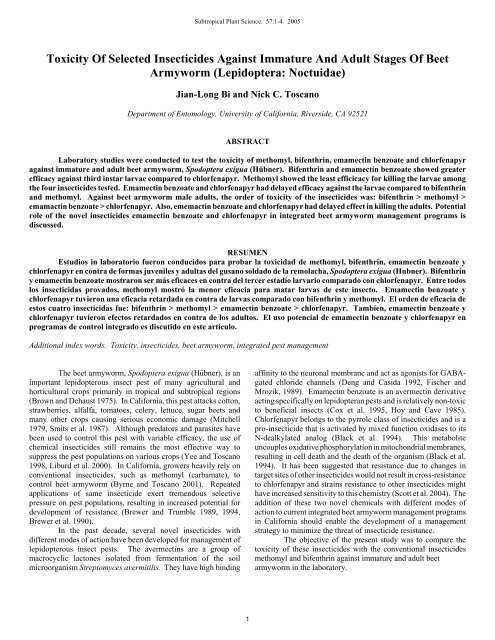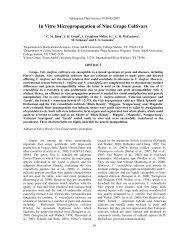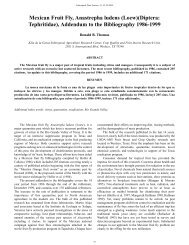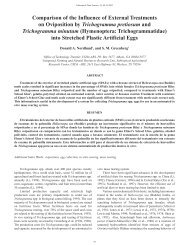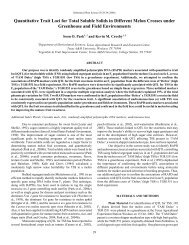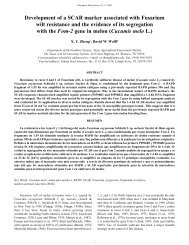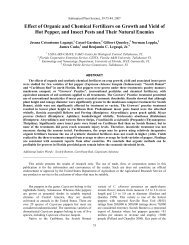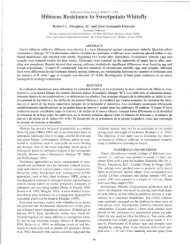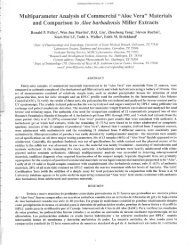Jian-Long Bi and Nick C. Toscano - Subtropical Plant Science Society
Jian-Long Bi and Nick C. Toscano - Subtropical Plant Science Society
Jian-Long Bi and Nick C. Toscano - Subtropical Plant Science Society
You also want an ePaper? Increase the reach of your titles
YUMPU automatically turns print PDFs into web optimized ePapers that Google loves.
<strong>Subtropical</strong> <strong>Plant</strong> <strong>Science</strong>. 57:1-4. 2005<br />
Toxicity Of Selected Insecticides Against Immature And Adult Stages Of Beet<br />
Armyworm (Lepidoptera: Noctuidae)<br />
<strong>Jian</strong>-<strong>Long</strong> <strong>Bi</strong> <strong>and</strong> <strong>Nick</strong> C. <strong>Toscano</strong><br />
Department of Entomology, University of California, Riverside, CA 92521<br />
ABSTRACT<br />
Laboratory studies were conducted to test the toxicity of methomyl, bifenthrin, emamectin benzoate <strong>and</strong> chlorfenapyr<br />
against immature <strong>and</strong> adult beet armyworm, Spodoptera exigua (Hübner). <strong>Bi</strong>fenthrin <strong>and</strong> emamectin benzoate showed greater<br />
efficacy against third instar larvae compared to chlorfenapyr. Methomyl showed the least efficicacy for killing the larvae among<br />
the four insecticides tested. Emamectin benzoate <strong>and</strong> chlorfenapyr had delayed efficacy against the larvae compared to bifenthrin<br />
<strong>and</strong> methomyl. Against beet armyworm male adults, the order of toxicity of the insecticides was: bifenthrin > methomyl ><br />
emamactin benzoate > chlorfenapyr. Also, ememactin benzoate <strong>and</strong> chlorfenapyr had delayed effect in killing the adults. Potential<br />
role of the novel insecticides emamectin benzoate <strong>and</strong> chlorfenapyr in integrated beet armyworm management programs is<br />
discussed.<br />
RESUMEN<br />
Estudios in laboratorio fueron conducidos para probar la toxicidad de methomyl, bifenthrin, emamectin benzoate y<br />
chlorfenapyr en contra de formas juveniles y adultas del gusano soldado de la remolacha, Spodoptera exigua (Hubner). <strong>Bi</strong>fenthrin<br />
y emamectin benzoate mostraron ser más eficaces en contra del tercer estadío larvario comparado con chlorfenapyr. Entre todos<br />
los insecticidas provados, methomyl mostró la menor eficacia para matar larvas de este insecto. Emamectin benzoate y<br />
chlorfenapyr tuvieron una eficacia retardada en contra de larvas comparado con bifenthrin y methomyl. El orden de eficacia de<br />
estos cuatro insecticidas fue: bifenthrin > methomyl > emamectin benzoate > chlorfenapyr. Tambíen, emamectin benzoate y<br />
chlorfenapyr tuvieron efectos retardados en contra de los adultos. El uso potencial de emamectin benzoate y chlorfenapyr en<br />
programas de control integrado es discutido en este artículo.<br />
Additional index words. Toxicity, insecticides, beet armyworm, integrated pest management<br />
The beet armyworm, Spodoptera exigua (Hübner), is an<br />
important lepidopterous insect pest of many agricultural <strong>and</strong><br />
horticultural crops primarily in tropical <strong>and</strong> subtropical regions<br />
(Brown <strong>and</strong> Dehaust 1975). In California, this pest attacks cotton,<br />
strawberries, alfalfa, tomatoes, celery, lettuce, sugar beets <strong>and</strong><br />
many other crops causing serious economic damage (Mitchell<br />
1979, Smits et al. 1987). Although predators <strong>and</strong> parasites have<br />
been used to control this pest with variable efficacy, the use of<br />
chemical insecticides still remains the most effective way to<br />
suppress the pest populations on various crops (Yee <strong>and</strong> <strong>Toscano</strong><br />
1998, Liburd et al. 2000). In California, growers heavily rely on<br />
conventional insecticides, such as methomyl (carbamate), to<br />
control beet armyworm (Byrne <strong>and</strong> <strong>Toscano</strong> 2001). Repeated<br />
applications of same insecticide exert tremendous selective<br />
pressure on pest populations, resulting in increased potential for<br />
development of resistance (Brewer <strong>and</strong> Trumble 1989, 1994,<br />
Brewer et al. 1990).<br />
In the past decade, several novel insecticides with<br />
different modes of action have been developed for management of<br />
lepidopterous insect pests. The avermectins are a group of<br />
macrocyclic lactones isolated from fermentation of the soil<br />
microorganism Streptomyces avermitilis. They have high binding<br />
affinity to the neuronal membrane <strong>and</strong> act as agonists for GABAgated<br />
chloride channels (Deng <strong>and</strong> Casida 1992, Fischer <strong>and</strong><br />
Mrozik, 1989). Emamectin benzoate is an avermectin derivative<br />
acting specifically on lepidopteran pests <strong>and</strong> is relatively non-toxic<br />
to beneficial insects (Cox et al. 1995, Hoy <strong>and</strong> Cave 1985).<br />
Chlorfenapyr belongs to the pyrrole class of insecticides <strong>and</strong> is a<br />
pro-insecticide that is activated by mixed function oxidases to its<br />
N-dealkylated analog (Black et al. 1994). This metabolite<br />
uncouples oxidative phosphorylation in mitochondrial membranes,<br />
resulting in cell death <strong>and</strong> the death of the organism (Black et al.<br />
1994). It has been suggested that resistance due to changes in<br />
target sites of other insecticides would not result in cross-resistance<br />
to chlorfenapyr <strong>and</strong> strains resistance to other insecticides might<br />
have increased sensitivity to this chemistry (Scott et al. 2004). The<br />
addition of these two novel chemicals with different modes of<br />
action to current integrated beet armyworm management programs<br />
in California should enable the development of a management<br />
strategy to minimize the threat of insecticide resistance.<br />
The objective of the present study was to compare the<br />
toxicity of these insecticides with the conventional insecticides<br />
methomyl <strong>and</strong> bifenthrin against immature <strong>and</strong> adult beet<br />
armyworm in the laboratory.<br />
1
<strong>Subtropical</strong> <strong>Plant</strong> <strong>Science</strong>. 57:1-4. 2005<br />
MATERIALS AND METHODS<br />
Insects <strong>and</strong> insecticides. Beet armyworm used in the<br />
bioassay was from a susceptible colony collected from Orange<br />
County, California, <strong>and</strong> was maintained at the University of<br />
California at Riverside. The colony was subjected to periodic<br />
infusion of wild insects. Larvae were maintained on an artificial<br />
diet as described by Patana (1985). Insecticides used in the<br />
experiment were as follows: bifenthrin (FMC, Philadelphia, PA),<br />
methomyl (DuPont, Wilmington, DE), emamectin benzoate<br />
(Syngenta, Greensboro, NC), <strong>and</strong> chlorfenapyr (Olympic Hort.<br />
Products, Mainl<strong>and</strong>, PA). These chemicals were diluted in acetone<br />
for different concentrations.<br />
<strong>Bi</strong>oassays. Third instar larval <strong>and</strong> adult male beet<br />
armyworm were used to test the toxicity of the insecticides. The<br />
mean larval weight was 7.5 mg <strong>and</strong> the mean weight of adults was<br />
37.0 mg. There were no significant differences among initial<br />
weights of the larvae or adults used in the experiment (P < 0.05).<br />
For test purposes, 0.5 μl <strong>and</strong> 1 μl of each concentration of diluted<br />
insecticides or acetone control were delivered to the thoracic<br />
dorsum of larva <strong>and</strong> adult, respectively, with an Arnold<br />
microapplicator (Burkard, Rickmansworth, Engl<strong>and</strong>). The<br />
concentrations (μg AI/μl) of each insecticide used in the test<br />
against larvae were as follows, methomyl: 0.212, 0.425, 0.850,<br />
1.700, 3.400, 6.800, <strong>and</strong> 13.600; bifenthrin: 0.003, 0.006, 0.0120,<br />
0.024, 0.048, 0.080, <strong>and</strong> 0.100; ememectin benzoate: 0.002, 0.005,<br />
0.010, 0.02, 0.050, <strong>and</strong> 0.080; chlorphenapyr: 0.100,0.200, 0.400,<br />
0.800, 1.200, 1.600, 2.400, <strong>and</strong> 4.800. The concentrations (μg<br />
AI/μl) of each insecticide used in the test against adults<br />
were:methomyl, 0.026, 0.053, 0.160, 0.212, 0.320, <strong>and</strong> 0.425;<br />
bifenthrin, 0.010, 0.0125, 0.020, 0.030, 0.040, <strong>and</strong> 0.050;<br />
emamectin benzoate, 0.08, 0.160, 0.320, 0.640, 1.280, 2.560, <strong>and</strong><br />
5.120; chlorfenapyr, 0.200, 0.400, 0.800, 1.600, 2.400, 4.800, <strong>and</strong><br />
9.600. Those concentrations of each insecticide covered 5-95%<br />
mortality of the tested insects. A minimum of twenty larvae or<br />
adults was treated with each concentration of each insecticide.<br />
Each larva was held in a 30-ml plastic cup filled with artificial diet.<br />
Beet armyworm adults were incubated in groups of 10 moths per<br />
oviposition cage with 10% sugar solution for nourishment.<br />
Mortality of insects for each dosage of the insecticides was<br />
recorded at 24 h intervals up to 96 h after application. Insects were<br />
considered dead if they did not move when prodded with a<br />
dissecting needle.<br />
Data analysis. The resulting data were corrected for<br />
control mortality (Abbott, 1925) <strong>and</strong> analyzed by probit analysis<br />
using POLO-PC (LeOra Software 1987). LD 50 <strong>and</strong> LD 90 for each<br />
insecticide were determined for each 24 h interval (24, 48, 72, 96<br />
h) after the treatment. Differences in LD 50s <strong>and</strong> LD 90s were<br />
considered significantly different if their respective 95% CL did not<br />
overlap.<br />
Table 1. Toxicity of selected insecticides to beet armyworm third instar larvae.<br />
Insecticides<br />
Hours after<br />
application n Slope ± SE<br />
a<br />
LD 50<br />
(95% CL)<br />
a<br />
LD 90<br />
(95% CL)<br />
Methomyl 24 275 1.04 ± 0.16 53.33 a<br />
(19.27-93.05)<br />
904.38 a<br />
(404.49-6724.87)<br />
48 275 1.12 ± 0.17 42.14 a<br />
(17.50-69.76)<br />
581.73 a<br />
(308.82-2125.37)<br />
72 275 1.06 ± 0.17 31.34 a<br />
(10.35-55.52)<br />
512.40 a<br />
(268.15-1997.42)<br />
96 275 1.07 ± 0.17 29.21 a<br />
(7.90-54.46)<br />
466.19 a<br />
(237.57-2092.69)<br />
<strong>Bi</strong>fenthrin 24 250 1.50 ± 0.24 0.64 a<br />
(0.40-0.89)<br />
3.74 a<br />
(2.66-14.20)<br />
48 250 1.57 ± 0.24 0.57 a<br />
(0.33-0.81)<br />
3.74 a<br />
(2.23-11.62)<br />
72 250 1.71 ± 0.25 0.56 a<br />
(0.33-0.79)<br />
3.13 a<br />
(1.94-8.68)<br />
96 250 1.71 ± 0.25 0.56 a<br />
(0.33-0.79)<br />
3.13 a<br />
(1.94-8.68)<br />
Emamectin<br />
benzoate<br />
24 275 1.56 ± 0.18 0.91 a<br />
(0.53-1.60)<br />
6.05 a<br />
(2.90-35.92)<br />
48 275 1.59 ± 0.19 0.36 b<br />
(0.22-0.52)<br />
2.29 ab<br />
(1.45-5.00)<br />
72 275 1.62 ± 0.20 0.24 b<br />
(0.14-0.33)<br />
1.45 b<br />
(0.98-2.64)<br />
96 275 1.97 ± 0.24 0.19 b<br />
(0.07-0.31)<br />
0.85 b<br />
(0.51-2.37)<br />
Chlorfenapyr 24 275 1.57 ± 0.20 24.64 a<br />
(14.57-36.68)<br />
160.65 a<br />
(91.36-522.15)<br />
48 275 1.92 ± 0.21 18.93 a<br />
(10.58-28.15)<br />
88.14 a<br />
(55.34-214.04)<br />
72 275 2.07 ± 0.22 17.92 a<br />
(11.13-25.24)<br />
74.48 a<br />
(50.33-144.11)<br />
96 275 2.15 ± 0.23 17.58 a<br />
(11.06-24.58)<br />
69.28 a<br />
(47.47-129.19)<br />
a μg AI g -1 larva body weight, column values within an insecticide <strong>and</strong> a lethal concentration followed<br />
by different letters are significantly different (non-overlap of 95% CL).<br />
2
<strong>Subtropical</strong> <strong>Plant</strong> <strong>Science</strong>. 57:1-4. 2005<br />
RESULTS<br />
Different insecticides had different efficacies against the<br />
beet armyworm based on the results of LD 50 in the 24 to 96 h test<br />
period (Tables 1 <strong>and</strong> 2). <strong>Bi</strong>fenthrin <strong>and</strong> emamectin benzoate<br />
showed greater efficacy against third instar larvae with low LD 50<br />
values (0.64 to 0.56 μg g -1 larva for bifenthrin, <strong>and</strong> 0.91 to 0.19 μg<br />
g -1 larva for emamectin benzoate from 24 to 96 h post treatment)<br />
compared to chlorfenapyr where the LD 50 s ranged from 26.44 to<br />
17.58 μg g -1 larva (Table 1). Methomyl showed the highest LD 50<br />
values (53.33 to 29.21 μg g -1 larva) among the four insecticides<br />
tested (Table 1). Emamectin benzoate <strong>and</strong> chlorfenapyr had<br />
delayed efficacy to the larvae compared to bifenthrin <strong>and</strong><br />
methomyl, due to the sharp decreases of the LD 50 values from 24<br />
to 96 h after being applied (Table 1). LD 90 values of these<br />
insecticides for the third instars followed the same order as the<br />
LD 50 s (Table 1). Against beet armyworm male adults, the order of<br />
LD 50 values of the insecticides were: bifenthrin (0.97 to 0.53 μg g -1<br />
larva), methomyl (4.29 to 2.95 μg g -1 larva), emamectin benzoate<br />
(257.31 to 4.44 μg g -1 larva), <strong>and</strong> chlorfenapyr (579.41 to 10.17 μg<br />
g -1 larva) (Table 2). LD 90 s for the adults were: bifenthrin (1.99 to<br />
1.30 μg g -1 adult), methomyl (12.25 to 12.13 μg g -1 adult),<br />
emamectin benzoate (957.45 to 18.71 μg g -1 adult), <strong>and</strong><br />
chlorfenapyr (2226.23 to 63.35 μg g -1 adult) (Table 2). Also,<br />
emamectin benzoate <strong>and</strong> chlorfenapyr had delayed effect in killing<br />
the adults (Table 2).<br />
DISCUSSION<br />
Our results indicate that emamectin benzoate is a powerful<br />
toxicant against the larval beet armyworm, <strong>and</strong> the efficacy is<br />
comparable to that of bifenthrin <strong>and</strong> far superior to that of<br />
methomyl (Table 1). Apparent toxicity is several days delayed<br />
compared to that of bifenthrin or methomyl due to their different<br />
modes of action (Table 1). The contact efficacy of emamectin<br />
benzoate against adult beet armyworm is comparable to that of<br />
methomyl (Table 2). These results generally agree with previous<br />
reports (Jansson et al. 1996, Dunbar et al. 1996, Ishaaya et al.<br />
2001). Emamectin benzoate is extremely selective at killing<br />
lepidopterous pests, while conserving natural enemies, thus is<br />
compatible with IPM goals (Hoy <strong>and</strong> Cave, 1985, Jansson et al.<br />
1996, Ishaaya et al. 2001).<br />
Our results also show that chlorfenapyr is a potent<br />
insecticide against immature beet armyworm (Table 1), consistent<br />
with previous report (Wier et al. 1994). The efficacy was greater<br />
than that of methomyl but lower than that of bifenthrin, agreeing<br />
with results of our field tests on lettuce (Table 1, <strong>Toscano</strong> et al.<br />
unpublished data). Chlorfenapyr is in the pyrrole class of<br />
Table 2. Toxicity of selected insecticides to beet armyworm adults<br />
Insecticides<br />
H after<br />
application n Slope ± SE<br />
a<br />
LD 50<br />
(95% CL)<br />
a<br />
LD 90<br />
(95% CL)<br />
Methomyl 24 340 2.81 ± 0.26 4.29 a<br />
(3.18-5.86)<br />
12.25 a<br />
(8.33-25.37)<br />
48 340 2.66 ± 0.24 3.98 a<br />
(2.94-5.44)<br />
11.92 a<br />
(8.15-25.07)<br />
72 340 2.51 ± 0.23 3.62 a<br />
(2.70-4.86)<br />
11.73 a<br />
(7.99-23.24)<br />
96 340 2.09 ± 0.21 2.95 a<br />
(2.16-3.96)<br />
12.13 a<br />
(8.03-25.17)<br />
<strong>Bi</strong>fenthrin 24 320 4.08 ± 0.53 0.97 a<br />
(0.84-1.14)<br />
1.99 a<br />
(1.57-3.05)<br />
48 320 4.16 ± 0.55 0.76 ab<br />
(0.65-0.86)<br />
1.54 a<br />
(1.27-2.12<br />
72 320 3.37 ± 0.52 0.64 b<br />
(0.49-0.76)<br />
1.53 a<br />
(1.22-2.28)<br />
96 320 3.26 ± 0.51 0.53 b<br />
(0.38-0.65)<br />
1.30 a<br />
(1.04-1.89)<br />
Emamectin<br />
benzoate<br />
24 320 2.25 ± 0.51 257.31 a<br />
(140.24-402.72)<br />
957.45 a<br />
(552.32-5881.87)<br />
48 320 1.48 ± 0.18 26.31 b<br />
(18.40-36.74)<br />
192.38 b<br />
(115.89-443.57)<br />
72 320 2.28 ± 0.33 9.15 c<br />
(6.19-11.98)<br />
33.46 c<br />
(25.73-48.58)<br />
96 320 2.05 ± 0.28 4.44 d<br />
(2.82-6.08)<br />
18.71 c<br />
(14.12-26.99)<br />
Chlorfenapyr 24 340 2.19 ± 0.48 579.41a<br />
(412.04-1147.76)<br />
2226.23 a<br />
(1130.85-13541.33)<br />
48 340 2.22 ± 0.33 129.71 b<br />
(77.64-193.11)<br />
490.98 ab<br />
(300.77-1522.27)<br />
72 340 1.91 ± 0.23 32.08 c<br />
(13.43-53.30)<br />
150.84 bc<br />
(89.14-406.27)<br />
96 275 1.61 ± 0.21 10.17 c<br />
(4.05-17.26)<br />
63.35 c<br />
(37.97-147.06)<br />
a μg AI g -1 larva body weight, column values within an insecticide <strong>and</strong> a lethal concentration followed<br />
by different letters are significantly different (non-overlap of 95% CL).<br />
3
<strong>Subtropical</strong> <strong>Plant</strong> <strong>Science</strong>. 57:1-4. 2005<br />
insecticides with a novel mode of action. Insect resistance to other<br />
insecticides may not result in cross-resistance to this insecticide<br />
<strong>and</strong> strains resistant to other insecticides might be more sensitivive<br />
to this chemistry (Scott et al. 2004). Therefore, chlorfenapyr is<br />
potentially a potent component in IPM programs to control the beet<br />
armyworm (Wier et al. 1994). Chemical control is still an<br />
important component of IPM systems. In California, growers rely<br />
on conventional insecticides such as methomyl, chlorpyrifos <strong>and</strong><br />
pyrethroids to control the beet armyworm on various crops.<br />
Widespread tolerance to some of these compounds has been<br />
reported in California <strong>and</strong> other areas (Brewer <strong>and</strong> Trumble 1989,<br />
1994, Brewer et al. 1990; Mascarenhas et al. 1998). Introducing<br />
<strong>and</strong> alternating emamectin benzoate <strong>and</strong> chlorfenapyr into the<br />
current beet armyworm management programs will be strategic to<br />
alleviate the risk of insecticide resistance. The results of this study<br />
can also serve as baselines for resistance monitoring programs.<br />
ACKNOWLEDGEMENTS<br />
We thank John Trumble (University of California, Riverside) for<br />
supplying beet armyworm for this study <strong>and</strong> Shu-Tang Zhou for<br />
technical assistance. This research was supported in part by<br />
California Iceberg Lettuce Advisory Board.<br />
REFERENCES CITED<br />
Abbott, W.S. 1925. A method for computing the effectiveness<br />
of an insecticide. J. Econ. Entomol. 18: 265-267.<br />
Black, B.C.; R.M. Hollingworth, K.I. Ahammadsahib, C.D.<br />
Kukel, <strong>and</strong> S. Donovan. 1994 Insecticidal action <strong>and</strong><br />
mitochondrial uncoupling activity of AC-303,630 <strong>and</strong><br />
related halogenated pyrroles. Pesticide <strong>Bi</strong>ochem. Physiol.<br />
50: 115-128.<br />
Brewer, M.J., <strong>and</strong> J.T. Trumble. 1989. Field monitoring for<br />
insecticide resistance in beet armyworm (Lepidoptera:<br />
Noctuidae). J. Econ. Entomol. 82: 1520-1526.<br />
Brewer, M.J., <strong>and</strong> J.T. Trumble. 1994. Beet armyworm<br />
resistance to fenvalerate <strong>and</strong> methomyl: resistance variation<br />
<strong>and</strong> insecticide synergism. J. Agric. Entomol. 11: 291-300.<br />
Brewer, M.J., J.T. Trumble, B. Alvarado-Rodriguez, <strong>and</strong> W.E.<br />
Chaney. 1990. Beet armyworm (Lepidoptera: Noctuidae)<br />
adult <strong>and</strong> larval susceptibility to three insecticides in<br />
managed habitats <strong>and</strong> relationship to laboratory selection for<br />
resistance. J. Econ. Entmol. 83: 2136-2146.<br />
Brown, E.S., <strong>and</strong> C.F. Dewhurst. 1975. The genus Spodoptera<br />
(Lepidoptera, Noctuidae) in Africa <strong>and</strong> the Near east. Bull.<br />
Entomol. Res. 65: 221-262.<br />
Byrne, F.J., <strong>and</strong> N.C. <strong>Toscano</strong>. 2001. An insensitive<br />
acetylcholinesterase confers resistance to methomyl in the<br />
beet armyworm Spodoptera exigua (Lepidoptera:<br />
Noctuidae). J. Econ. Entomol. 94: 524-528.<br />
Cox, D.L., A.L. Knight, D.G. <strong>Bi</strong>ddinger, J.A. Lasota, B.<br />
Pikonuis, L.A. Hull, <strong>and</strong> R.A. Dybas. 1995. Toxicity <strong>and</strong><br />
field efficacy of avermectines against colding moth<br />
(Lepidoptera: Tortricidae) on apples. J. Econ. Entomol. 88:<br />
708-715.<br />
Deng, Y., <strong>and</strong> J.E. Casida. 1992. Housefly head GABA-gated<br />
chloride channel: toxicological relevant binding site for<br />
avermectines couples for ethynyl-bicycloortho benzoate.<br />
Pesticide <strong>Bi</strong>ochem. Physiol. 43: 116-122.<br />
Dunbar, D.M, R.D. Brown, J.A. Norton, <strong>and</strong> R.A. Dybas. 1996.<br />
Proclaim: a new insecticide for use on cotton, pp. 756-758.<br />
In P. Dugger <strong>and</strong> D. Richer (eds.). Proc. Beltwide Cotton<br />
Research Conf. Natl. Cotton Council of Am, Memphis, TN.<br />
Fischer, M.H., <strong>and</strong> H. Mrozik. 1989. Chemistry, pp. 105-124.<br />
In W.C. Campbell, (ed), Ivermectin <strong>and</strong> abamectin.<br />
Springer, Berlin Heidelberg New York.<br />
Hoy, M.A., <strong>and</strong> F.E. Cave. 1985. Laboratory evaluation of<br />
avermectin as a selective acaricide for use with Metasciulus<br />
occiddentalis (Nesbitt) (Acarina: Phytiseiidae). Exp. Appl.<br />
Acarol. 1: 139-152.<br />
Ishaaya, I., S. Kontsedalov, D. Mazirov, <strong>and</strong> A.R. Horowitz.<br />
2001. <strong>Bi</strong>orational agents – mechanism <strong>and</strong> importance in<br />
IPM IRM programs for controlling agricultural pests. Med.<br />
Fac. L<strong>and</strong>bouww. Univ. Gent. 66: 363-374.<br />
Jansson, R.K., R.F. Peterson, W.R. Halliday, P.K. Mookerjee,<br />
<strong>and</strong> R.A. Dybas. 1996. Efficacy of solid formulations of<br />
emamectin benzoate at controlling lepidopterous pests.<br />
Florida Entomol. 79: 434-449.<br />
LeOra Software. 1987. POLO-PC. A user’s guide to probit or<br />
logit analysis. LeOra Software, Berkeley, CA.<br />
Liburd, O.E., J.E. Funderburk, <strong>and</strong> S.M. Olson. 2000. Effect of<br />
biological <strong>and</strong> chemical insecticides on Spodoptera species<br />
(Lep., Noctuidae) <strong>and</strong> marketable yields of tomatoes. J.<br />
Appl. Ent. 124: 19-25.<br />
Mascarenhas V.J., J.B. Graves, B.R. Leonard, <strong>and</strong> E. Burris.<br />
1998. Susceptibility of field populations of beet armyworm<br />
(Lepidoptera: Noctuidae) to commercial <strong>and</strong> experimental<br />
insecticides. J. Econ. Entomol. 91: 827-833.<br />
Mitchell, E.R. 1979. Migration by Spodoptera exigua <strong>and</strong><br />
Spodoptera frugiperda North America Style, pp. 386-395.<br />
In Rabb <strong>and</strong> Kennnedy (eds.). Movement of highly mobile<br />
insects: concepts <strong>and</strong> methodology. University Graphics,<br />
North Carolina State University, Raleigh, NC.<br />
Patana, R. 1985. Sopdoptera exigua, pp. 465-469. In P. Singh<br />
<strong>and</strong> R. F. Moore (eds.), H<strong>and</strong>book of insect rearing.<br />
Elsevier, Amsterdam.<br />
Scott, J.G., C.A. Leichter, <strong>and</strong> F.D. Rinkevich. 2004.<br />
Insecticide resistance strains of houseflies (Musca<br />
domsetica) show limited cross-resistance to chlorfenapyr. J.<br />
Pesticide Sci. 29: 124-126.<br />
Smits, P.H., M.C. Van Velden, M. Van De Vrie, J.M. Vlak.<br />
1987. Feeding <strong>and</strong> dispersion of Spodoptera exigua larvae<br />
<strong>and</strong> its relevance for control with nuclear polyhedrosis virus.<br />
Entomol. Exp. Appl. 43: 67-72.<br />
Wier, A.T., D.J. Boethel, B.R. Leonard, <strong>and</strong> E. Burris. 1994.<br />
Laboratory toxicity <strong>and</strong> field efficacy of AC 303,630<br />
(Pirate) against beet armyworm, Spodoptera exigua<br />
(Hubner), larvae. J. Agric. Entomol. 11: 311-320.<br />
Yee, W L., <strong>and</strong> N.C. <strong>Toscano</strong>. 1998. Laboratory evaluations of<br />
synthetic <strong>and</strong> natural insecticides on beet armyworm<br />
(Lepidoptera: Noctuidae) damage <strong>and</strong> survival on lettuce. J.<br />
Econ. Entomol. 91: 56-63.<br />
4


